
Leros: The Island Prize is a board wargame published by The Gamers in 1996 that simulates the Battle of Leros during World War II. The game is the 8th in the "Tactical Combat Series" of games that use an identical series of rules.

Leros: The Island Prize is a board wargame published by The Gamers in 1996 that simulates the Battle of Leros during World War II. The game is the 8th in the "Tactical Combat Series" of games that use an identical series of rules.
On 8 September 1943, Italy revealed that they had signed the Armistice of Cassibile with the Allies. As German forces responded by attacking Italian forces and taking command of the Italian peninsula, British forces landed on the Italian-controlled island of Leros and dug in. The Germans responded by heavily bombing the island for 8 weeks, then sent a force to make amphibious and airdrop landings, which were furiously contested by the British and Italians. [1]
Leros is a two-player board wargame where one player controls the German attackers, and the other player controls British and Italian defenders. The game, having 60 pages of rules, almost 600 die-cut counters, and three large 22" x 34" hex grid maps that together cover the entire island at a scale of 125 yd (115 m) per hex, is a relatively complex tactical game. [2]
Five scenarios simulate the various phases of the battle, each using only one or two of the three maps. There is also a campaign game that combines all five scenarios, uses all three maps, and is estimated to take 10–20 hours to complete. [3]
The game uses the Tactical Combat Series (TSC) general rules which use the following sequence of play: [3]
This completes one turn, which represent 20 minutes of game time. [2]
There are also special rules that apply specifically to Leros. For example, during a firefight, one player can demand surrender rather than annihilating the remaining enemy. [3]
In 1989, Dean Essig of The Gamers designed the wargame Bloody 110, the first in a planned series of World War II wargames that would use the same set of rules. As more games in the series were published and issues cropped up with the rules, new versions of the TCS rules were published, always usable for all previously published games in the series. In 1996, The Gamers published Leros, the 8th game in the series, designed by David A. Friedrichs to use version 3.1 of the TCS rules.
The Gamers published a total of fourteen games in the series. Multiman Publishing then acquired the game rights and created another four TCS games.
In Issue 7 of Zone of Control, Steve Poitinger called Leros an "intriguing game". He noted that the campaign game required a lot of space and many hours of play, but highly recommended the campaign game over the shorter scenarios. "Yes, you can play one- and two-map scenarios. No, they aren't nearly as much fun as the three-map campaign game. [...] Those who can't satisfy the [needed] time and space requirements won't fully appreciate the Leros operation." Poitinger thought the German side was the more interesting force to handle, since the German player has to decide when and how to land. "The possibilities are fascinating. Do you send in lots of men at once, or stagger landings in order to give lead elements time to take out key coastal guns and defenses? Do you go at night or at dawn? Do you try a diversionary strike, or is brute force the best approach?" Poitinger concluded by giving the game an "Excellent" rating, saying, "The system really seems to capture the ebb, flow, maneuver, and overwatch of modern tactical combat. [...] If you're not afraid to take a few risks, it'll keep you on the edge of your seat for hours at a time." [3]
In Issue 45 of The Canadian Wargaming Journal , Keith Martens liked the quality of the components, noting that they "hardly need any comment since The Gamers' quality is always there." Martens also liked the TCS rules, commenting that "The ability of both sides to reinforce the battle [...] spices things up. Also even open ground gives fire protection encouraging movement and a mobile helter-skleter battle." Martens concluded on a positive note, saying, "The full campaign area, interesting units and sweeping manoeuvres of Leros make it a great game, one that should entertain you for many hours." [2]

Air Assault on Crete is a wargame published by Avalon Hill in 1977 that simulates the Battle of Crete during World War II.

The Arab-Israeli Wars, subtitled "Tank Battles in the Mideast 1956–73", is a board wargame published by Avalon Hill in 1977 that simulates various battles during the Suez Crisis, Six-Day War and Yom Kippur War.

War and Peace, subtitled Game of the Napoleonic Wars: 1805–1815, is a board wargame published by Avalon Hill in 1980 that simulates ten years of Napoleonic wars.

Armageddon: Tactical Combat, 3000-500 BC is a board wargame first published by Simulations Publications Inc. (SPI) in 1972 in Strategy & Tactics, then released as a stand-alone game, then reimplemented as Chariot: Tactical Warfare in the "Biblical" Age, 3000-500 BC.

Napoleon's Last Battles is a board wargame published by Simulations Publications in 1976 that simulates the last four battles fought by Napoleon. It was one of SPI's most popular games, and also received many positive reviews.
La Bataille de la Moscowa is a board wargame published originally by Martial Enterprises in 1975, later republished by Game Designers Workshop in 1977, and by Clash of Arms in 2011.
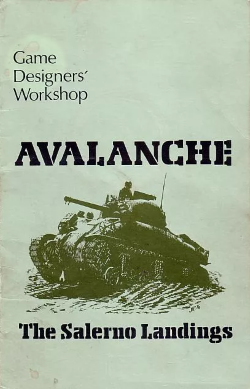
Avalanche: The Salerno Landings is a board wargame published by Game Designers' Workshop (GDW) in 1976 that simulates the nine-day battle for the beachhead at Salerno in September 1943 following the Allied amphibious landing known as Operation Avalanche.
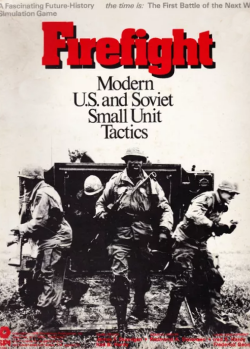
Firefight: Modern U.S. and Soviet Small Unit Tactics is a tactical wargame originally published by Simulations Publications, Inc. (SPI) in 1976 that hypothesizes combat between small units of American and Soviet forces in West Germany in the 1970s.
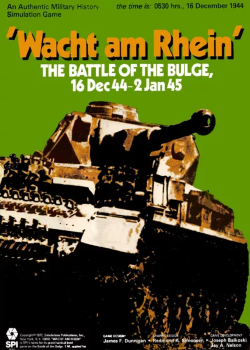
Wacht am Rhein is a grand tactical monster board wargame published by Simulations Publications, Inc. (SPI) in 1977 that simulates Germany's Battle of the Bulge offensive in late 1944 during World War II.

Narvik: The Campaign in Norway, 1940 is a board wargame published by Game Designers' Workshop (GDW) in 1974 that simulates Operation Weserübung, the German invasion of Denmark and Norway during World War II. The game was one of the first in the Europa series of twenty interlocking games envisioned by GDW that would cover the entire European and North African theatres from the start to the end of World War II, using identical map scales and similar rules.
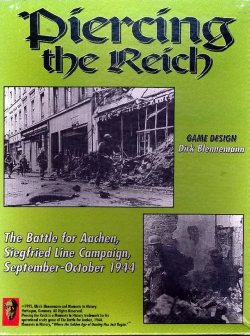
Piercing the Reich, subtitled "The Battle for Aachen, Siegfreid Line Campaign, September–October 1944", is a board wargame published by Moments in History (MiH) in 1995 that is an operational simulation of the Battle of Aachen during World War II.

Dieppe, subtitled "An Operational Game of the Allied Raid on Fortress Europe, August 1942", is a board wargame published by Simulations Canada in 1977 that is a simulation of Operation Jubilee, the disastrous Dieppe Raid made by Canadian and British forces during World War II.

Combined Arms, subtitled "Combat Operations in the 20th Century", is a board wargame published by Simulations Publications Inc. (SPI) in 1974 that simulates various combat engagements in the mid-twentieth century

El Alamein: Battles in North Africa, 1942 is a board wargame published by Simulations Publications Inc. (SPI) in 1973 that simulates the final four months of the North African campaign during World War II.
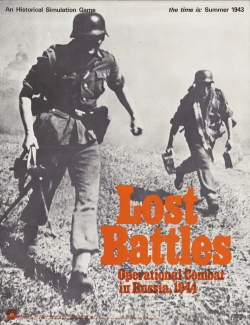
Lost Battles: Operational Combat in Russia is a board wargame published by Simulations Publications Inc. (SPI) in 1971 that simulates hypothetical combat situations set in the Soviet Union during World War II.

Bloody Ridge, subtitled "Turning Point on Guadalcanal, September 1942", is a board wargame published by Simulations Publications Inc. (SPI) in 1975 that simulates the Guadalcanal Campaign during World War II. The game was originally published as part of the Island War: Four Pacific Battles "quadrigame" — a gamebox containing four games simulating four separate battles that all use the same rules. Bloody Ridge was also published as an individual "folio game."

Atlantic Wall, subtitled "The Invasion of Europe June 1944", is a board wargame published by Simulations Publications Inc. (SPI) in 1978 that simulates Operation Overlord during World War II, when Allied forces landed on Normandy beaches and attempted to break out into open country.
Tsushima is a board wargame published by Game Designers' Workshop (GDW) in 1975 that simulates naval battles during the Russo-Japanese War of 1904-1905. Tsushima was part of a two-game collection titled The Russo-Japanese War. The second game in the box was Port Arthur, which covered the land combat during the war. The two games could either be played separately, or combined into one master game.

Invasion: Sicily – Alexander vs Kesselring is a board wargame published by Rand Game Associates in 1974 that simulates the Allied invasion of Sicily during World War II.

Omaha Beach is a board wargame published by Rand Game Associates (RGA) in 1974 that simulates the American landings on Omaha Beach as part of the D-Day landings during World War II.